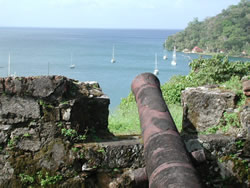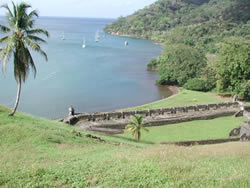|
January 17,
2001
Rio Chagres, Panama
Latitude: 09-17.70N
Longitude: 079-59.00W
Sailing west from the
San Blas along Panama's north (Caribbean) coast has brought us along
some of the most historic bays in the country. Back in the1500-1700s,
when the Spanish were plundering the riches of the New World, these
were the harbors from which they transshipped their loot, and thus
these were the harbors that drew the attacks of the pirates, privateers,
and navy.
Our 40-mile sail from
Chichime brought us to a dramatic inland pass between Isla Grande
and the mainland just about where the isthmus writhes most northward.
The mouth of this channel is marked by a pair of dark island humps
on one side and a buried reef on the other around all of which the
swells break and churn. We sailed through to find that Isla Grande
is a popular resort area, with a crowded beach, buildings in bright
primary colors and not a thatch hut in sight. What a change! A cluster
of neglected looking boats rolled at anchor, so we passed on through
to Isla Linton to find calm water in the channel between it and
the mainland (09-36.80N; 079-35.10W) … along with about thirty
other cruisers.
 Isla
Linton, it turned out, belongs to the rather impressive estate facing
it. The owner has made his property a de facto bird sanctuary, which
visitors can often explore with permission. Unfortunately the owner
was in the hospital following a helicopter crash several days earlier,
so such permission was not available, but we could hear a new-age
symphony of tropical birds each evening. Isla Linton he has made
into a refuge for injured animals. We dropped the hook off an abandoned
house and dock, only to quickly realize that this little estate
belonged to a group of four monkeys. Now, we have traveled many
miles in the Caribbean, and the closest we have gotten to monkeys
in the wild is the Howlers of Scotland Bay in Trinidad, which were
mostly heard and not seen. On Linton, the four residents were not
a bit shy, and we enjoyed watching them lounging on the empty window
ledges, climbing palms in the front yard, and soliciting handouts
from cruisers in dinghies at the dock. The word was out early that
the monkeys could switch from charming to aggressive in the blink
of an eye, so most cruisers contented themselves with dropping treats
off at the dock and backing off to watch. Although we haven't yet
pinned down the species (Panama has four), we are fairly sure they
are NOT Howlers. They are about 3.5-4 feet tall, of slight build,
and mostly dark brown, although one had a blonde mantle of hair
on his head and shoulders. They walk on all fours or upright like
a pot-bellied old man interchangeably. Either way their long tails
are carried straight up to the sky, and when they have something
to say it's a rather sweet little chirp. Isla
Linton, it turned out, belongs to the rather impressive estate facing
it. The owner has made his property a de facto bird sanctuary, which
visitors can often explore with permission. Unfortunately the owner
was in the hospital following a helicopter crash several days earlier,
so such permission was not available, but we could hear a new-age
symphony of tropical birds each evening. Isla Linton he has made
into a refuge for injured animals. We dropped the hook off an abandoned
house and dock, only to quickly realize that this little estate
belonged to a group of four monkeys. Now, we have traveled many
miles in the Caribbean, and the closest we have gotten to monkeys
in the wild is the Howlers of Scotland Bay in Trinidad, which were
mostly heard and not seen. On Linton, the four residents were not
a bit shy, and we enjoyed watching them lounging on the empty window
ledges, climbing palms in the front yard, and soliciting handouts
from cruisers in dinghies at the dock. The word was out early that
the monkeys could switch from charming to aggressive in the blink
of an eye, so most cruisers contented themselves with dropping treats
off at the dock and backing off to watch. Although we haven't yet
pinned down the species (Panama has four), we are fairly sure they
are NOT Howlers. They are about 3.5-4 feet tall, of slight build,
and mostly dark brown, although one had a blonde mantle of hair
on his head and shoulders. They walk on all fours or upright like
a pot-bellied old man interchangeably. Either way their long tails
are carried straight up to the sky, and when they have something
to say it's a rather sweet little chirp.
We spent two nights in
Isla Linton. During the day between we had our first restaurant
meal in months over on Isla Grande. Like any good follower of Jimmy
Buffet, the menu item most on the mind was a good old-fashioned
greasy cheeseburger in Paradise. However, what we got when we ordered
"hamburgesas" came bun-less and cheese-less. Fortunately,
it was tasty and the draft beers were 65 cents.
From Isla Linton we sailed
south a few miles to José Pobré where a Swiss sailor
has built a business called Marco's Marina (09-36N 79-38W). There
is no marina at Marco's Marina. What there is is a "yacht storage
facility" behind some reef and mangroves. The boats are anchored
bow and stern, side by side, in protected water, which is accessed
by a narrow channel the entrepreneurs blasted through the reef.
Although a couple of our friends have left their boats here for
a few months back in the States, most of the boats here are European.
Our reason for stopping was to have lunch with the German couple
Benno and Marlene that we came to know in the Roches and the Aves
this summer. By wonderful coincidence we learned they'd flown in
the day before, so we got together over a lunch of lobster, mackerel
and pulpos (octopus) at Marco's. Octopus is a specialty of this
region, and it was superb. Benno and Marlene are joining a German
boat to help with their passage to Tahiti.
After lunch, we enjoyed
a perfect sail another six miles west to Portobelo (09-33.50N; 079-40.10W).
My first glimpse of Portobelo was on a video made by Judy Knape's
brother and his family as they rushed by to the Canal on the first
leg of their now completed circumnavigation. The harbor caught my
imagination then, and I was determined to visit it. Portobelo became
the Spaniard's principal transshipment port in 1596 when the privateer
Francis Drake cleaned out the goodies and torched the previous treasure
port of Nombre de Dios about 20 miles to the east. The Spaniards
then constructed four forts and several batteries on the shores
of this deep and beautiful bay, and they did a great job with construction
because most of the fortifications still stand. Unfortunately it
didn't stop the raids by pirates and their ilk, and in 1739 Portobelo
was "destroyed" by British Admiral Edward Vernon, after
which the Spanish gave up their Central American "shortcut"
and opted for the route round the Horn!
 After
rounding the Drake's Rock, so named because Drake's body was buried
at sea nearby, we cruised in to anchor off the bay's north shore
underneath the most striking of the remaining forts. In the morning
we hiked up the three levels of the fort….our first foray with
shoes in months, not to mention our first steep climb in months
…to be rewarded at the top with a great view…and a heavy
rain! The lower two fortifications had dozens of gun emplacements
for cannons and a thick-walled powder magazine. The upper battlement
was a neat square with a dry moat around it, a well or cistern in
the center, and two levels of slits for soldiers with muskets ...
the last retreat. After
rounding the Drake's Rock, so named because Drake's body was buried
at sea nearby, we cruised in to anchor off the bay's north shore
underneath the most striking of the remaining forts. In the morning
we hiked up the three levels of the fort….our first foray with
shoes in months, not to mention our first steep climb in months
…to be rewarded at the top with a great view…and a heavy
rain! The lower two fortifications had dozens of gun emplacements
for cannons and a thick-walled powder magazine. The upper battlement
was a neat square with a dry moat around it, a well or cistern in
the center, and two levels of slits for soldiers with muskets ...
the last retreat.
Along the way up and
down we spent much time checking out the elaborate highway system
of a colony of leaf-cutter ants. These guys follow highways not
just across the path, but for a hundred feet or so up and down the
path, to fell, cut and transport dime-sized pieces of leaf back
to the home place. Mostly they carry the leaf bit upright like a
sail, but we were fascinated to watch one ant work determinedly
to get his piece under an obstacle. It involved a dozen tries with
the leaf in different positions, with a smaller ant riding on top
for ballast!
Although there are some
upscale homes on the shores of the bay, the town of Portobelo itself
is pretty simple, belonging to fisherman and farmers. Simple homes
and shops are built in and on centuries-old ruins. However, the
supplies available compared to the San Blas impressed us fine. Salad
suddenly and wholeheartedly returned to everybody's menu!
On Friday, we hitched
up with our friends Mac and Sam of Sandi Lee to adventure into Colón
by bus. These busses, by the way, are old Blue Bird school buses
shipped down from the States for a second lease on life. Don's Dad
has a post-retirement job of collecting retired school busses to
go back to Blue Bird. Now we know where they end up. Once here they
receive a total cosmetic makeover via fanciful and colorful paint
jobs, sometimes extending to the interior. Little else, however
changes, including the size and spacing of the seats. Fortunately,
most Central Americans are elementary school sized!
The object of our bus
trip was, after two months in limbo in the San Blas, to officially
clear into Panama. This system makes no sense to me, but it's how
they do it. Colón, the Caribbean terminus of the Panama Canal,
has a dreadful reputation for personal street safety and our bus
driver actually
kept us aboard after the bus terminal and drove us directly to the
Panama Canal Yacht Club, home base and safe turf for yachties in
Colón. There we came into the care of Alphonso who shepherded
us through the paper chase, which required four stops in different
locales. For all the anxiety over the complicated process, everything
went without a hitch, except for one official whose signature was
needed being out of the office for a funeral. Alphonso dropped us
at the yacht club for lunch and took our passports back for the
signature. Couldn't be eaier!
Saturday morning we sailed
about 25 miles west right past Colón and all the waiting
ships to the Rio Chagres. The Rio Chagres was part of the Spaniards'
overland treasure route. They schlepped all the booty across the
isthmus from Panama City to the Chagres and then floated it down
to the mouth where it was then moved by boat to the storehouses
in Nombre de Dios and, later, Portobelo from where it was loaded
onto the galleons bound for Spain.
 We
entered the river mouth under Fort San Lorenzo, wending our way
through the reefs and bars, and then proceeded about three miles
upriver, which is 30-60' deep. This is the first river for TII and
the 2Cs, and it's TII's first taste of fresh water. We expected
to see other boats because it is said to be a popular getaway from
Colón, but so far we have had it all to ourselves. This is
the first time we have been totally alone that we can remember!
The river is wide and tranquil with banks overhung by jungle becoming
taller and denser the farther we go. We have seen no more monkeys,
but we can hear Howlers roaring in several different directions.
We were hoping to see a lot of birds, but so far we have heard more
than we've seen. "Song" is not the word for it, however;
the sound is like a blend of Woolworth's parakeet section, a turkey
farm and a car crash. Every plop in the water has us on the lookout
for caimans (brackish-water alligators), but so far we've seen none.
We won't be swimming, though. We
entered the river mouth under Fort San Lorenzo, wending our way
through the reefs and bars, and then proceeded about three miles
upriver, which is 30-60' deep. This is the first river for TII and
the 2Cs, and it's TII's first taste of fresh water. We expected
to see other boats because it is said to be a popular getaway from
Colón, but so far we have had it all to ourselves. This is
the first time we have been totally alone that we can remember!
The river is wide and tranquil with banks overhung by jungle becoming
taller and denser the farther we go. We have seen no more monkeys,
but we can hear Howlers roaring in several different directions.
We were hoping to see a lot of birds, but so far we have heard more
than we've seen. "Song" is not the word for it, however;
the sound is like a blend of Woolworth's parakeet section, a turkey
farm and a car crash. Every plop in the water has us on the lookout
for caimans (brackish-water alligators), but so far we've seen none.
We won't be swimming, though.
At night, the sky was
crystal clear and the water so still it was like being anchored
in a reflecting pool. Ahead of us the loom of Colón backlit
the treeline, and we sat for some time on the foredeck drinking
it all in.
In the morning we motored
upstream to explore and reached to within sight of the dam built
to create Gatun Lake, the man-made reservoir supplying the operational
needs of the Panama Canal. It takes 52 million gallons of water
to lock a ship from ocean to ocean (over 30 ships transit the Canal
a day) and it all comes from the Rio Chagres watershed! The river
didn't change much as we went inland, narrowing a little, but we
did see more birdlife, specifically little blue herons, egrets and
what we take to be swallow-tailed kites (a type of hawk) since the
guidebook says we would see them! We also had a delightful flock
of little birds with metallic blue backsides - either swallows or
swifts or maybe plovers (birding is not our
forte) - that hitched rides with us both ways on the anchor! We
anchored midstream for lunch and afterwards had a bit of a challenge
getting the anchor free of some underwater obstruction. Now there's
a thought...a fouled anchor 40 feet down in a river with alligators!
Yikes! Good thing we have knack for psyching the anchor free! Now
we are back in last night's anchorage with a load of clean sheets
on the line (love that washer!), and preparing tomorrow to bash
our way back to Colón, where begins our transit to the Pacific!
|